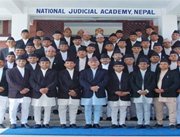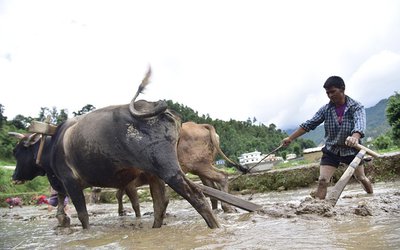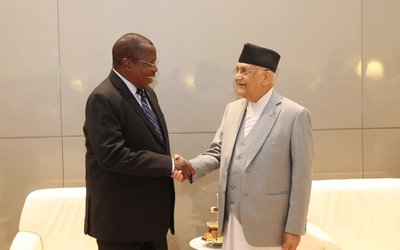
As of early June, the Judicial Council recommended a list of candidates for the vacant positions of District and Appellate Judges to the Chief Justice of Nepal after a thorough process of scanning and securitization.
After an induction training provided by the Nepal Judicial Academy, these judges have now started carrying out their responsibilities in various districts and zone of Nepal.
The Judicial Council, established under the article 113 of the Interim constitution, 2007, is responsible for giving recommendations and advice concerning the appointment of, transfer of, disciplinary action against, and dismissal of Judges, alongside other judicial administration.
The body consists of the Chief Justice of Nepal as Chairperson, and the Minister of Justice, one senior-most Judge of the Supreme Court, one legal expert nominated by the President on the recommendation of the Prime Minister, one other senior advocate, or an advocate who has at least twenty years of experience to be appointed by the Chief Justice on the recommendation of the Nepal Bar Association as members.
With the appointment of judges concluded, even now, the Judiciary consists of only five female judges as opposed to 164 males. Himalayan news states that at present, “there are only two percent women in the judiciary,” a problem that in Nepal’s context is not very shocking. Regarding representation in other areas as well, like the executive branch, civil service, the Nepal Police, and the army, women make up less than 15 percent of the groups. In the Nepalese Supreme Court, which has been responsible for ameliorating laws to address gender equality and promoting equal gender representation in different aspects of the government, there is only a single female permanent judge at the Supreme Court, Sushila Karki.
Dr Bipin Adhikari, a senior constitutional expert, said, “The image of justice as a blindfolded woman balancing scales is a very illustrious example in the legal sector. However, in the system that we have, it is still difficult for women and candidates from most of the ethnic communities to be appointed judge and take on this responsibility due to various obstacles. These obstacles must be removed. It is clear that the Judicial Council has not been able to do it.”
But all is not lost. Although still underrepresented, the Government of Nepal has seen an increase in the participation of women in government, especially as members of the Constituent Assembly. In the dissolved CA of 2007, 32% of the members were women, a must that the Interim Constitution of Nepal 2007 clearly stated: “Notwithstanding anything contained in this clause, in case of women, there should be at least one third of total representation obtained…”
Although there is positivity and hopefulness in the increasing numbers of women participating in the government, there is still a lack when it comes to women representation in the most powerful, decision-making sectors of the government, like the Supreme Court and the Judicial Council.
This is true universally as well, where women of position say that an explanation could be that women are too easily content with what they have. Maria Bartiromo, the first, regular reporter from the New York Stock Exchange and a respected financial journalist worldwide, states that the problem with women is that they “tend to be satisfied with the status quo. They won’t push … they’ll say, let’s keep it as it is.” Victoria Medvec, a Northwestern University professor, adds that women don’t negotiate, take risks, or demand for work, all of which leads to a slower or even nonexistent climb up the ladder.
In Nepal’s context, there are many reasons why women do not hold the top positions. Advocate Anita Sapkota Chapagain, who is a learned woman lawyer, said, “Qualifications are laid out clearly in the law, and most of the female candidates meet these qualities. The reason why only few women candidates were appointed by the Judicial Council is that there are fewer numbers of women candidates. Fewer women practice law too.”
Judge Yamuna Bhattarai, who was appointed the Appellate Court Judge, added, “We need to question how neutral the Judicial Council itself is. Around 50 women candidates gave the exam, but only such few were selected. Is the standard being maintained? If so, why is there no proof? Why aren’t they showing us the results of the interview, the exams, or an explanation that shows why such few women were appointed?”
So where is the root of the problem? Bhattarai said, “The foundation of a good lawyer is a good education, of course. For women, this foundation needs to be strengthened. In areas where there is no female representation, like the district courts today, loser criteria and more flexibility need to be considered for there to be proportional representation.”
Not only the foundation, but the opportunities that come with a professional life are much limited for women, who are given simpler cases and lesser to work with than are men, said Advocate Chapagain.
As a growing problem of underrepresentation, not only in government but in other professions as well, there are solutions. Chapagain, said, “Judiciary should have strategies, rules, and regulations that ensure inclusiveness of women. Everything, from education to experience to training, should be considered, no matter the gender of the candidate. A positive attitude needs to be developed towards women lawyers.”
Dr Adhikari added on the topic of criteria that “This is not an issue of identity politics. Judges are appointed not for their gender or ethnic biases, but for their knowledge of law, judicial skills and ability to serve as independent arbiters of the law. Their gender and ethnicity is irrelevant in the judicial decision making.”
However, Adhikari is quick to add, “But we are a democracy. We cannot ignore the fact that the percentages of women and most of the ethnic groups in judgeships have not reflected their proportion in the national population. There are many communities in Nepal, which never had the honour of getting a candidate from among them appointed as a judge. This deficit has become a growing concern for organizations focused on issues of equality and non-discrimination. So this problem must be addressed as soon as possible so that it does not get overwhelmed by identity politics.”
Aside from proportional representation, women can bring a lot into the court. Advocate Chapagain said, “There are set laws that women need to work under. But compared to men, women are more sensitive, energetic, and can delivery justice by practicing reason. They can bring new perspective.”
The report published by National Judicial Academy on Gender Equality and Social Inclusion Analysis of the Nepali Judiciary suggests several ways to improve the situation.
The government needs to ensure that it is providing special provisions to encourage more and more women to pursue a legal education and put it to practice. Arrangements in scholarship need to made. To overcome the mindset that women can’t hold decision-making positions, special awareness programs and classes need to be given, to males and females alike. Women themselves need to realize that they need to push themselves and the system in order to go ahead and not settle down with the bare minimum.
The idea of equal representation needs to be emphasized even in the highest sectors of non-judicial decision-making.
- Highlights of KUSL’s Launching Ceremony
- Aug 17, 2014
- Labour Force Leaving The Country
- Mar 24, 2014
- Thinking about Nepal’s Think Tanks
- Nov 10, 2013
- The five years’ BBM-LLB Course of the Kathmandu University Law School
- Sep 13, 2013
- Kathmandu University’s Initiation of a Legal Education
- Aug 08, 2013
















